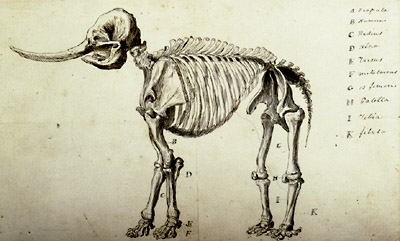 In 1712, when the divine Cotton Mather provided the first scientific description of an American mastodon, the huge size of the remains attracted immediate attention on both sides of the Atlantic. Yet in a culture in which extinction was not thought possible and scriptural precepts governed scientific analysis, mastodons defied analysis. Their bones were usually identified as belonging to giant humans or, after their affinities with modern elephants were recognized, as animals that had perished in the Noachian flood. For some observers, the long, curving tusks and the high-crowned teeth suggested that mastodons were fierce carnivores terrorizing the ante-diluvean landscape, while for others, the similarity to elephants suggested peaceful herbivory.
In 1712, when the divine Cotton Mather provided the first scientific description of an American mastodon, the huge size of the remains attracted immediate attention on both sides of the Atlantic. Yet in a culture in which extinction was not thought possible and scriptural precepts governed scientific analysis, mastodons defied analysis. Their bones were usually identified as belonging to giant humans or, after their affinities with modern elephants were recognized, as animals that had perished in the Noachian flood. For some observers, the long, curving tusks and the high-crowned teeth suggested that mastodons were fierce carnivores terrorizing the ante-diluvean landscape, while for others, the similarity to elephants suggested peaceful herbivory.
As more and more reports of fossilized remains of mastodons filtered in from travelers and scientists visiting such exotic locales as Salt Lick, Kentucky (later renamed Big Bone Lick), the problem of interpretation steadily mounted. By the early National period, fossil proboscidians were the center of enormous popular interest, and were written about and discussed by everyone from George Washington and Benjamin Franklin to Thomas Jefferson. In this crowd, not coincidentally, these native American creatures began to acquire a new set of meanings.
In 1801, a mastodon specimen was discovered near Newburgh, N.Y., and the operator of the famed Philadelphia Museum, Charles Willson Peale, was called in to assist. Peale, the polymathic "artist of the American Revolution," brought along his son, Rembrandt, to assist, and together they excavated an almost complete skeleton, illustrated here in 1801 (above right) by Rembrandt. Lugging the bones back to Philadelphia, the Peales painstakingly mounted the specimen for display, and soon chimed in on the debate regarding the nature of mastodons, arguing that the beasts were mighty carnivores. If nothing else, the interpretation was good for business: the display became one of the most popular natural historical exhibits of the period, drawing thousands over the years.
 To the Peales and their friend Jefferson, however, the mastodon was far more than an exciting exhibit, it was a natural hymn for their new nation. Prior to the American Revolution, the great French natural historian, George Louis LeClerc de Buffon, had proposed that the environment in North American was so impoverished relative to that of the Old World that it could support only a weak and degenerate fauna. Buffon and his followers insisted that when subjected to North American conditions, even the largest and most robust animals would decline in stature and decrease in vigor.
To the Peales and their friend Jefferson, however, the mastodon was far more than an exciting exhibit, it was a natural hymn for their new nation. Prior to the American Revolution, the great French natural historian, George Louis LeClerc de Buffon, had proposed that the environment in North American was so impoverished relative to that of the Old World that it could support only a weak and degenerate fauna. Buffon and his followers insisted that when subjected to North American conditions, even the largest and most robust animals would decline in stature and decrease in vigor.
As native-born Americans and promoters of their new republic, Jefferson and the Peales saw little to like in such theories. In his Notes on the State of Virginia, Jefferson directed a fierce counter-attack at Buffon, using the mastodon as his centerpiece. A bigger version of the African elephant, found all over the country from the western states to Virginia and New England, the mastodon was proof that America could and would sustain large and vigorous life forms, perhaps even larger and more vigorous than Europe. Best of all, it was clear that the mastodon was unique to North America, a symbol of the antiquity of our continent and exemplar of the new nation. Jefferson may well have had the Peales' mastodon in mind when he enjoined Lewis and Clark to scour the western landscape for mastodons, living or dead.
